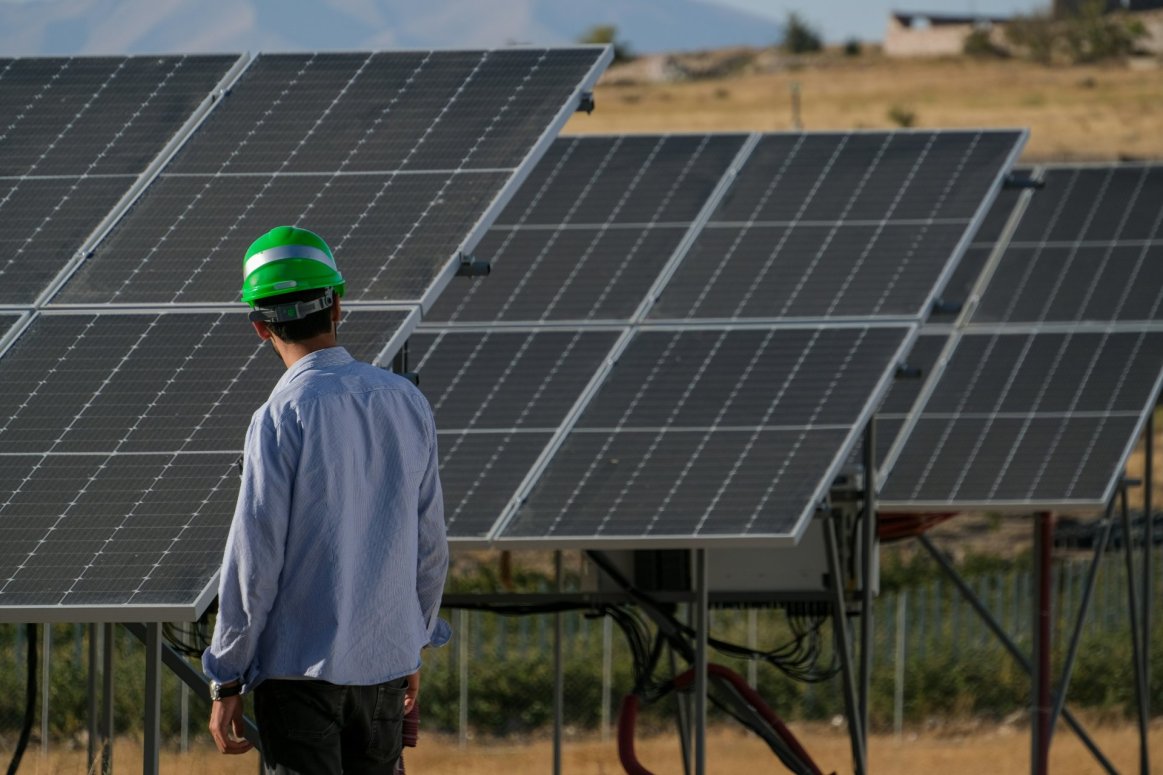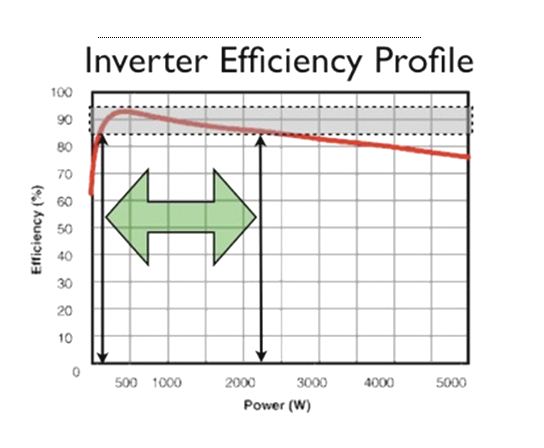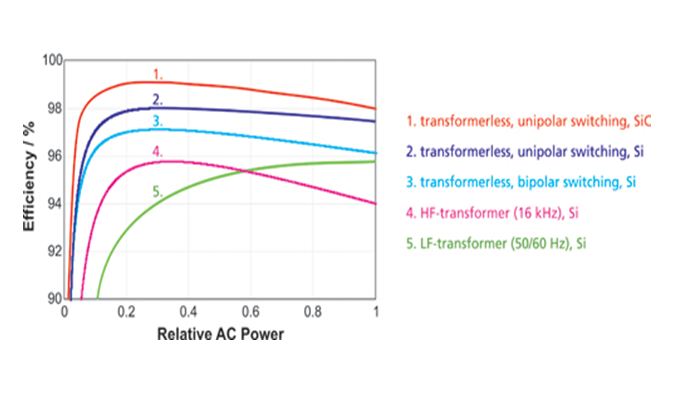
What is a transformerless (TL) inverter?
Transformers
The differences between standard or conventional inverters and transformerless inverters are:
- Conventional inverters are built with an internal transformer that synchronizes the DC voltage with the AC output.
- Transformerless (TL) inverters use a computerized multi-step process and electronic components to convert DC to high frequency AC, back to DC, and ultimately to standard-frequency AC.
Transformerless inverters are increasing in popularity in European and Australian markets. In 2010, SMA Solar Technology AG earned the first UL certification for their transformerless inverters, thereby increasing product availability for residential consumers in the United States.
Transformerless (TL) Inverter Appeal
Transformerless inverters are light, compact, and relatively inexpensive. Since transformerless inverters use electronic switching rather than mechanical switching the amount of heat and humidity produced by standard inverters is greatly reduced.
TL inverters maintain the unique ability to utilize two power point trackers that allow installations to be treated as separate Solar PV Systems. In other words with TL inverters, Solar PV Panels can be installed in two different directions (i.e. north and west) on the same rooftop and generate DC output at separate peak hours with optimal effects. Traditional inverters work through only one power point, which means panels that are performing at lower frequencies will lower DC output for the entire system.
Transformerless (TL) Inverter Considerations
Transformerless inverters do not have electrical isolation between DC and AC circuits. This may raise some grounding and / or lightning protection concerns. In order for transformerless inverters to comply with NEC specifications specially designed and more expensive PV Wire must be used.
Transformerless inverters have been developed for use with Grid-Tie Solar PV Systems, so Off-Grid systems users will not necessarily achieve the same benefit yet.
Inverter Efficiency
Inverter efficiency is determined by the percentage measurement of energy convergence (i.e. the closer to 100% of DC to AC convergence for the longest amount of time the more refined inverter efficiency). When calculating efficiency it is important to include peak and off-peak performance percentages in addition to how often your inverter is operating at rated capacity.
Studies show that even a small percentage increase in inverter efficiency means the power supply increase can be quite significant if factored throughout the life span of the inverter.


Installation Considerations for TL Inverters:
- The positive and negative PV source circuits must BOTH be switched and over-current protected with TL Inverters.
- The PV array equipment must still be grounded, but not the PV source.
- The modules and the source circuits must use wire rated PV WIRE or PV CABLE.
- The negative conductor of the PV array is not grounded, and therefore shall no longer be colored white when terminating at the inverter or disconnect. Refer to NEC 690.35 for some relavent TL inverter information
- PV source circuits shall be labeled with the following warning at each junction box, combiner box, disconnect, and device where the ungrounded circuits may be exposed during service:
WARNING
ELECTRIC SHOCK HAZARD
THE DC CONDUCTORS OF THIS
PHOTOVOLTAIC SYSTEM ARE
UNGROUNDED AND MAY BE ENERGIZED
Possible Benefits of using a Transformerless Inverter:
- Usually much lighter in weight than inverters with transformers.
- Have higher efficiency ratings
- Capable of dual MPPT inputs, depending on the manufacturer
Comments
Question. Is SMA the only company making a transformerless inverter or are there other products like this on the market? Thanks.
In the US, you can buy SMA, Kaco and PowerOne transformerless inverters at this time.
I was looking through the SMA HF inverter manuals and couldn't find any reference to your comment ...
In order for transformerless inverters to comply with NEC specifications specially designed and more expensive PV Wire must be used.
Can you be specific as to exactly what wire can be used? I am currently in the middle of my first HF install and we are using #10 THHN/THWN as we almost always do. Will this suffice? Any insight would be appreciated.
-Chris
Chris,
The PV source is ungrounded - so PV wire must be used in place of USE-2 wire. Once you are in the combiner box (and protected by conduit) you can use the THWN/THHN rated wires. PV wire has thicker insulation to (theoretically) reduce the chance of an exposed conductor energizing a metal structure. So, wherever you would have had USE-2 - from the module J-box to the DC combiner - you need PV wire.
Khaled,
You should ground PV modules and use overcurrent protection with TL inverters.
Hello Khaled,
I want to elaborate a little on my colleague Tom's response below. Regarding your questions:
The National Electrical Code requires any conductive surface that is at risk of being energized during a fault to be bonded to ground. So yes, metal frames associated with the solar module need to be bonded by earthing system. In the past, this meant routing an Equipment grounding conductor to each module and bonding it to the EGC routed back to inverter. Nowadays, most racking used in the PV industry is certified to UL2703 which means the clamps and rails of the racking system serve as the equipment ground path for the solar modules. Only a short jumper is needed from the rail to the EGC contained in conduit to complete bonding path back to inverter. For more detail, read the installation manual of the racking manufacturer that you plan to use for project. There should be a section on grounding.
Note, glass-on-glass modules or BIPV have no metal frames. So in this case, the modules do not need to be bonded to ground path.
I'm going to break your question into 2 parts, Switching & Overcurrent protection:
Switching: With TL inverters, any time you switch the dc conductors, both the positive and negative conductors need to be switched together, i.e. ganged. Almost all string inverters today contain an integrated DC disconnect and integrated DC combiner box. It's rare to need a DC disconnect external to the inverter unless you use an external DC combiner box.
Overcurrent protection:
For NEC 2014 or earlier, both the positive and negative DC conductors need an ocpd (when ocpd required). A change was made to NEC 2017 to allow only a single ocpd in the positive or negative DC PV Source or Output circuit (when ocpd required).
Note, I made a point to emphasize ocpd when required. Most residential PV systems installed today have no DC OCPD installed. Changes in inverter design (multiple MPPT, external optimizers, etc.) have negated the need for this DC ocpd. \
Hope this helps.
-Chad
Hi Chad,
Thanks for the insight.
I'm curious about the install manual language for SB-TL inverters which states:
"Do not operate grounded PV modules together with the product."
In light of the fact that most racking systems as you say provide a path to ground through the modules?
Adam,
I believe SMA used poor wording in this section. I think they meant to say "Do no ground either of the current carrying conductors (positive or negative) on the DC side. The inverter relies on a transformless, ungrounded topology."
Note, this section falls under the "No Galvanic isolation" header. They are attempting to clarify the difference in grounding scheme between this transformless, no galvanic isolation inverter and older inverter models that had integrated transformer and galvanic isolation. With an integrated, galvanic isolated transformer the DC system is separately derived from the ac side and typically necessitated bonding one of the circuit conductors to ground.
Also note how the next section states explicity to ground the module frames. This is in reference to equipment grounding. With both transformer integrated and transformerless inverters, the NEC requires that all "normally non-current-carrying electrically conductive materials that are likely to become energized shall be" bonded to earth.
I hope this helps clarify the issue and difference between system grounding and equipment grounding.
-Chad
You noted that "Transformerless inverters have been developed for use with Grid-Tie Solar PV Systems, so Off-Grid systems users will not necessarily achieve the same benefit yet." I'm wondering if you can elaborate.
I'm asking because I have a TL the mfg said is susceptible to electrical appliances that use diodes (SCRs or triacs), because they can alter the sine wave form returning to the TL and cause faults. I have not had a fault yet (few months of use) but I am noticing some light flicker and my computer UPS, which senses for black/brownouts and electrical noise (awaiting parameters from mfg), is registering a few seconds of routine electrical noise, I believe when my water pressure pump starts. The pump has a soft start, which may use diodes to control (awaiting info from mfg).
Thank you for your question. The reason off-grid inverters were mentioned specifically is that many still are transformer-based, and those models would not enjoy the lighter weight and higher efficiency of the transformerless inverters. With regards to the power quality, transformerless inverters will monitor the utility provided voltage and frequency just like a transformer-based unit. If a load at the premises is degrading the AC service that the inverter sees, it is possible that this could cause the inverter to disconnect. If the load has not caused this behavior over months, likely it will not be a problem. Changes in behavior from this pump due to its loading or environmental conditions it is experiencing could potentially make the situation worse, however, so it is worth monitoring. Let us know if you have any additional questions.
Since TL inverters are now the norm... What do you use to replace a SunPower Branded, SMA "SunnyBoy" SPR-4000m/SB4000US String Inverter (Transformer Based from 04/2009) that was factory modified for use with SunPower POSITIVE GROUND solar panels?
Thanks for reaching out. CED doesn't sell SunPower products. That being said, I would reuse the modules in a positively grounded DC-coupled Telcom site – wire them for -48V use to charge batteries.
SMA had 20-year warranties on some older products, try a warrantee claim.
Look into Alencon they make a galvanically isolated optimizer that should work with any modern string inverter. The smallest one might be viable for a 7kW SMA.
Good luck.
adolfo biagioni - please find attached a white paper with a comprehensive solution to your query.